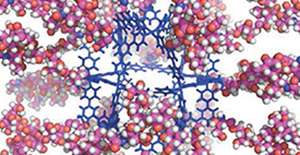Precise transplant of a biomolecule to a synthesized molecule

The research group of Prof. Makoto Fujita in the Department of Applied Chemistry, School of Engineering, The University of Tokyo, Prof. Koichi Kato in the Okazaki Institute for Integrative Bioscience, National Institutes of Natural Sciences/Institute for Molecular Science, and Associate Prof. Sota Sato in WPI-AIMR, Tohoku University have succeeded in the self-assembly of a sugar cluster with a sophisticated molecular design.
The self-assembly of organic molecules and transition-metal ions afforded a well-defined, world's largest spherical molecule just by mixing the starting materials.
The research group hybridized the sugar parts of biological origin to an artificially synthesized self-assembled supramolecule, and succeeded in the construction of a cyborg supramolecule. The hydrophobic environment traps a cohesive protein, and the interaction between the cohesive protein and a sugar cluster is not observable in the system. Therefore, the research group designed the cyborg molecule by tethering the sugar part of ganglioside GM1 with the removal of hydrophobic part to the spherical molecule bearing no hydrophobic environment like cellular membrane.
With the synthetic strategy, the sugar cluster of ganglioside GM1 was constructed with a precisely controlled structure; the number and position of sugar moieties are defined, and the surface curvedness was uniform over the molecule (see figure). For the sample solution of the sugar cluster and an amyloid β protein, a nuclear magnetic resonance (NMR) analysis revealed the selective recognition of the protein's N-terminal.
For another cohesive protein, α-synuclein, which is known to be involved in the pathogenic pathway of Parkinson's Disease, the recognition mechanism was also revealed in detail. The transplant of a biological sugar cluster to a well-defined artificial molecule with the retention of the original biological function realized the high-resolution analysis to reveal an undiscovered mechanism in vital phenomena.
Provided by Tohoku University



















